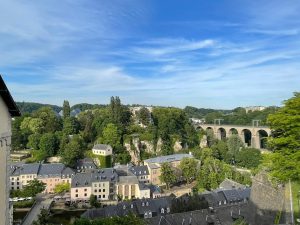Pro Silva Annual Meeting Luxembourg 2022
“Knowledge to the Foresters – Pro Silva as the knowledge hub for dissemination of Close to Nature Forestry”
 Foresters from across the world convened in Luxembourg this week for the 2022 Annual Meeting of Pro Silva, the organisation which promotes close-to-nature-forestry (CTNF) across Europe. This three-day event had been postponed twice due to the COVID-19 pandemic, but this year’s agenda was the most comprehensive yet, hosted by Pro Silva Luxembourg.
Foresters from across the world convened in Luxembourg this week for the 2022 Annual Meeting of Pro Silva, the organisation which promotes close-to-nature-forestry (CTNF) across Europe. This three-day event had been postponed twice due to the COVID-19 pandemic, but this year’s agenda was the most comprehensive yet, hosted by Pro Silva Luxembourg.
The meeting began on Wednesday with the Annual Board Meeting at Hotel Parc Belle-Vue in Luxembourg, where Pro Silva members discussed the current issues facing the sustainable management of European forests. For the first time, there was significant representation from Scandinavian and Baltic countries with new member Silva Ry from Finland, and participants from Sweden, Latvia, Estonia, and a new partnership with the International Forest Students Association (IFSA). Further afield, there was online participation from Brazil (ACEF), India (For EcoIndia), as well as Croatia, Portugal, Slovakia, Albania and Bosnia and Herzegovina.

 “At long last, Pro Silva members will come together this week to discuss the unprecedented issues and opportunities we are facing as owners and managers of European forests. We are extremely grateful to Pro Silva Luxembourg for their generous hosting of our 25th Annual Meeting, with an extensive programme exploring the themes of urban forestry, forest management and hydrology and the reconciliation of forestry, nature conservation and tourism. In 2017, at the Annual Meeting in Sibiu, Romania, we created the slogan ‘Transition to Transmission’ as a development task for Pro Silva looking forward. And now in Luxembourg in 2022, the main topic for discussion will be how Pro Silva can improve its function as a hub for the dissemination of science and evidence in close-to-nature forest management, which has been accumulated over 30 years since its inception in Slovenia in 1989” – Eckart Senitza, Chairman of Pro Silva.
“At long last, Pro Silva members will come together this week to discuss the unprecedented issues and opportunities we are facing as owners and managers of European forests. We are extremely grateful to Pro Silva Luxembourg for their generous hosting of our 25th Annual Meeting, with an extensive programme exploring the themes of urban forestry, forest management and hydrology and the reconciliation of forestry, nature conservation and tourism. In 2017, at the Annual Meeting in Sibiu, Romania, we created the slogan ‘Transition to Transmission’ as a development task for Pro Silva looking forward. And now in Luxembourg in 2022, the main topic for discussion will be how Pro Silva can improve its function as a hub for the dissemination of science and evidence in close-to-nature forest management, which has been accumulated over 30 years since its inception in Slovenia in 1989” – Eckart Senitza, Chairman of Pro Silva.
Topics of discussion initiated by foresters in Luxembourg included the conversion of monoculture plantations to uneven mixed forests; the restoration of the functions of forest soils, competition between Sessile oak and Beech, and the implementation of the ‘near-natural silviculture’ regulation. Also on the agenda was an update on the Pro Silva network of exemplary forests, which now totals 120 forest stands encompassing an area of 133,000 ha. These forests represent our best examples of close-to-nature forest management trajectories, providing the basis for data exchange and research, and a location for training and demonstration. Pro Silva Executive Assistant Anne Crespin will present the new CTNF training project under development at Forêt.Nature, and there were updates on other CTNF training initiatives across Europe including the Association Futaie Irrégulière in France, and ASKAFOR.
 From the boreal pine forests of Northern Scandinavia to the Pyrenean oak woods of Spain and Portugal, we already have the experience in how to transform European forests to a more resilient state. The pressing task now is how to effectively communicate and demonstrate this knowledge base so that policymakers, forest owners, forest managers, students and even farmers across Europe are empowered to utilise their forest resource and maintain their vitality in the process.
From the boreal pine forests of Northern Scandinavia to the Pyrenean oak woods of Spain and Portugal, we already have the experience in how to transform European forests to a more resilient state. The pressing task now is how to effectively communicate and demonstrate this knowledge base so that policymakers, forest owners, forest managers, students and even farmers across Europe are empowered to utilise their forest resource and maintain their vitality in the process.
Who we are
Pro Silva is a European organisation which promotes close to nature forestry and continuous cover forest systems. It was established in 1989 in Slovenia. At present there are 22 full members of the organisation and there are also several other countries with associate membership. Since 2018 we have associated members from the United States (Forest Stewards Guild, New England Forestry Foundation), from India (ForEco India), from Brazil (ACEF St. Catarina) and Canada (“Les Amis de la forêt Ouareau”) and hopefully this marks the beginning of the formation of a global network. More than 5500 professionals and forest owners are involved in Pro Silva.

Pro Silva promotes its principles and concepts through a Europe wide program of silvicultural education involving seminars and excursions. Increasingly the members are also involved as partners in national or international research and networking projects. A European network of best practice demonstration forests is being developed.
www.prosilva.org – www.prosilva.net – www.forestconservation.eu






 Following our most recent successful webinar we have now made a recording available on YouTube for anyone that missed it or would like to revisit:
Following our most recent successful webinar we have now made a recording available on YouTube for anyone that missed it or would like to revisit:  Foresters from across the world convened in Luxembourg this week for the 2022 Annual Meeting of Pro Silva, the organisation which promotes close-to-nature-forestry (CTNF) across Europe. This three-day event had been postponed twice due to the COVID-19 pandemic, but this year’s agenda was the most comprehensive yet, hosted by Pro Silva Luxembourg.
Foresters from across the world convened in Luxembourg this week for the 2022 Annual Meeting of Pro Silva, the organisation which promotes close-to-nature-forestry (CTNF) across Europe. This three-day event had been postponed twice due to the COVID-19 pandemic, but this year’s agenda was the most comprehensive yet, hosted by Pro Silva Luxembourg.
 “At long last, Pro Silva members will come together this week to discuss the unprecedented issues and opportunities we are facing as owners and managers of European forests. We are extremely grateful to Pro Silva Luxembourg for their generous hosting of our 25th Annual Meeting, with an extensive programme exploring the themes of urban forestry, forest management and hydrology and the reconciliation of forestry, nature conservation and tourism. In 2017, at the Annual Meeting in Sibiu, Romania, we created the slogan ‘Transition to Transmission’ as a development task for Pro Silva looking forward. And now in Luxembourg in 2022, the main topic for discussion will be how Pro Silva can improve its function as a hub for the dissemination of science and evidence in close-to-nature forest management, which has been accumulated over 30 years since its inception in Slovenia in 1989” – Eckart Senitza, Chairman of Pro Silva.
“At long last, Pro Silva members will come together this week to discuss the unprecedented issues and opportunities we are facing as owners and managers of European forests. We are extremely grateful to Pro Silva Luxembourg for their generous hosting of our 25th Annual Meeting, with an extensive programme exploring the themes of urban forestry, forest management and hydrology and the reconciliation of forestry, nature conservation and tourism. In 2017, at the Annual Meeting in Sibiu, Romania, we created the slogan ‘Transition to Transmission’ as a development task for Pro Silva looking forward. And now in Luxembourg in 2022, the main topic for discussion will be how Pro Silva can improve its function as a hub for the dissemination of science and evidence in close-to-nature forest management, which has been accumulated over 30 years since its inception in Slovenia in 1989” – Eckart Senitza, Chairman of Pro Silva. From the boreal pine forests of Northern Scandinavia to the Pyrenean oak woods of Spain and Portugal, we already have the experience in how to transform European forests to a more resilient state. The pressing task now is how to effectively communicate and demonstrate this knowledge base so that policymakers, forest owners, forest managers, students and even farmers across Europe are empowered to utilise their forest resource and maintain their vitality in the process.
From the boreal pine forests of Northern Scandinavia to the Pyrenean oak woods of Spain and Portugal, we already have the experience in how to transform European forests to a more resilient state. The pressing task now is how to effectively communicate and demonstrate this knowledge base so that policymakers, forest owners, forest managers, students and even farmers across Europe are empowered to utilise their forest resource and maintain their vitality in the process.
 Following our most recent successful webinar we have now made a recording available on YouTube for anyone that missed it or would like to revisit:
Following our most recent successful webinar we have now made a recording available on YouTube for anyone that missed it or would like to revisit:  Following our most recent successful webinar we have now made a recording available on YouTube for anyone that missed it or would like to revisit:
Following our most recent successful webinar we have now made a recording available on YouTube for anyone that missed it or would like to revisit: 